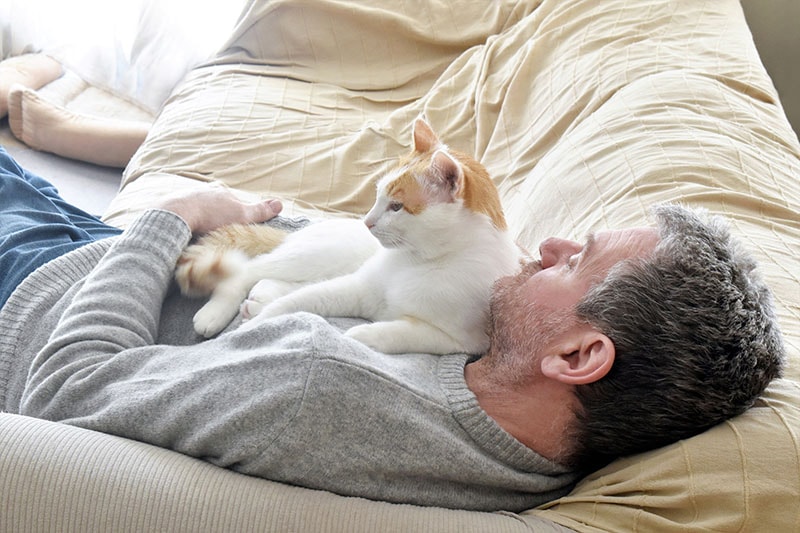VET APPROVED

The information is current and up-to-date in accordance with the latest veterinarian research.
Learn more »Click to Skip Ahead
Owning a cat is much different than having a dog. Dogs are social creatures that live in packs, while cats are independent, solitary hunters. That means the way they perceive your voice is different—a dog may see you as their protector, while a cat is happy to ignore you and groom itself. Unlike dogs, cats aren’t perturbed by alone time away from their humans.
This led to the myth that cats aren’t trainable because they don’t listen to your voice or come when you call them, but that’s not entirely true. Cats have been studied to see if they listen to their owners, and the results were surprising: they were found to perk up more to recordings of their owners’ voices than a stranger’s voice.1 Some cats can even learn simple commands, but training them is a bit different from training a dog.
If you’re interested in finding out more about why cats seem to not listen, how training them works, and more, you’ve come to the right place. Read below for the details.

Are Cats Trainable?

Cats know their owner’s voice and can hone in on it if they want, but they’re not as innately eager to please as a dog. Positive reinforcement is the key to training a cat, even only to not scratch your furniture or to stay away from certain areas. Some cats can be incentivized to learn simple commands and even tricks, but it requires a ton of patience, food, and a strong bond.
Let’s say you want to teach your cat to come when you call their name. They may even know their name already but simply have no reason to come when you call it. Praise and some chin scratches may work for more gregarious cats, but realistically, most cats want treats or food to do things.
You start by calling your cat’s name and looking for a reaction. Eventually, their ears will perk up, they’ll glance your way, or maybe even come to you. Liberally reward them with a high-value treat like a small piece of plain boiled chicken breast or a favorite treat when you see any acknowledgment. Cats easily understand cause and effect, and they’ll quickly understand that listening to you gets them delectable rewards.
Over time, you can simply pet your cat and give them praise along with the reward. Slowly reduce the number of treats or food you use as your bribe and taper it off until you only offer treats sporadically. Use them wisely, for example, when your cat has a fast and direct response when called, you can give them 3 treats at once. This way, you keep the element of surprise on your side and your cat will learn that if they come, there is a chance for something yummy, maintaining the positive association with listening to your voice.
How to Redirect Bad Behavior: Scratching & Biting

Cats don’t understand punishment, and you should never use it as a consequence for bad behavior or to deter it. For example, swatting at a cat when they bite you too hard will only make them afraid and anxious. They could associate you with being swatted and learn to simply avoid you to prevent it.
The same type of thing applies to unwanted scratching. If you catch them scratching and raise your voice at them or any other punishment, they’ll simply learn to scratch when you’re not around to avoid getting caught. It is a nightmare to find your cat’s been tearing up your new furniture, but positive redirect tactics are your best weapon. This goes hand in hand with positive reinforcement. Reinforce good behaviors and redirect bad behaviors.
Unwanted Scratching
Redirect unwanted scratching to a scratching post, which is a must-have for every cat owner. Add-ons like dangling mice, multiple levels, and appealing carpeted surfaces will increase the chances that your cat will prefer to scratch there instead of on your prized furniture. Make sure you pair their designated scratcher use with positive reinforcement, and soon, they will learn.
The Hepper Hi-Lo Cat Scratcher features a modern and clever design that offers cats an appealing place to scratch – and a way to keep them from scratching all the things they shouldn't. Unlike most cat toys (where your cat probably just prefers the cardboard box they came in), cat's flock to this design ... maybe it's because there's cardboard in it!
- Premium Materials - Hepper's cardboard scratcher is made with dense, B-flute cardboard, and a metal...
- High, Low and Lower - A single cat scratch pad won't keep your cat engaged. 3 unique positions keeps...
- Activates Muscles - The Hi Lo isn't just a cat nail file to stop the chief cat couch scratcher. The...
With its 3-position setup, textured cardboard, and sturdy frame, it encourages their natural scratching behavior, steering them away from clawing at items like furniture, walls, carpets, curtains, and people. The Hi-Lo is a reliable solution to safeguard your home and create a more enjoyable environment for your cat, all while looking modern and stylish.
At PangoVet, we've admired Hepper for many years, and decided to take a controlling ownership interest so that we could benefit from the outstanding designs of this cool cat company!
Biting or Aggression
Young kittens and unsocialized cats are more likely to bite too hard, and it’s easy for them to froth themselves into a kitty rage. When your cat bites you, make an effort to not react and instead ignore them completely. Simply remove yourself from the scenario and they will soon learn that biting stops playtime. And remember that cats learn in black and white, so you can not allow bites, not the soft ones and not the hard ones, either. Since bitting is a self-reinforced behavior, it’s one of those issues that can quickly escalate.
 Final Thoughts
Final Thoughts
Cats are the ultimate independent companion, so it can be easy to think they’re ignoring you and simply give up. Getting your cat to listen to you can be hard, but motivating them using positive reinforcement, treats, and lots of patience will go a long way toward winning over their furry little heart.
Featured Image Credit: rebecaml, Pixabay












